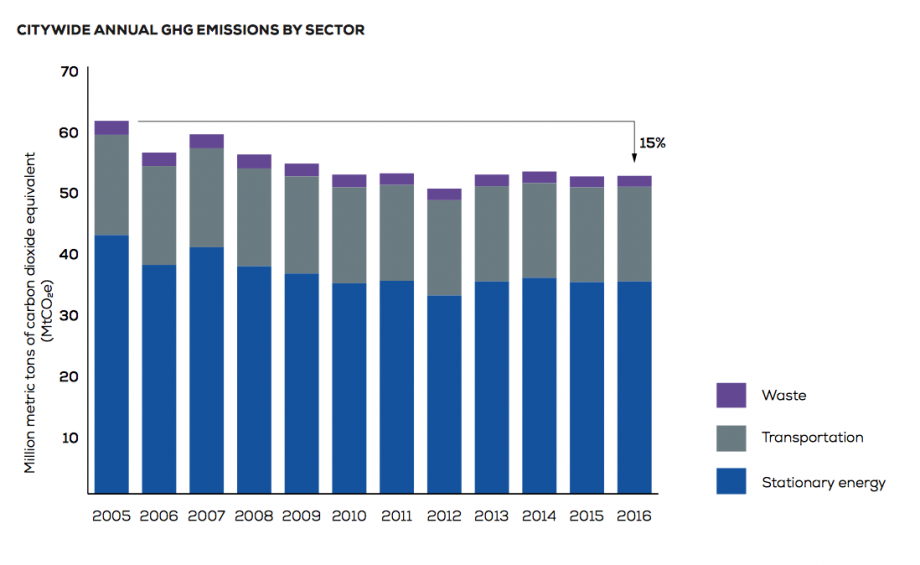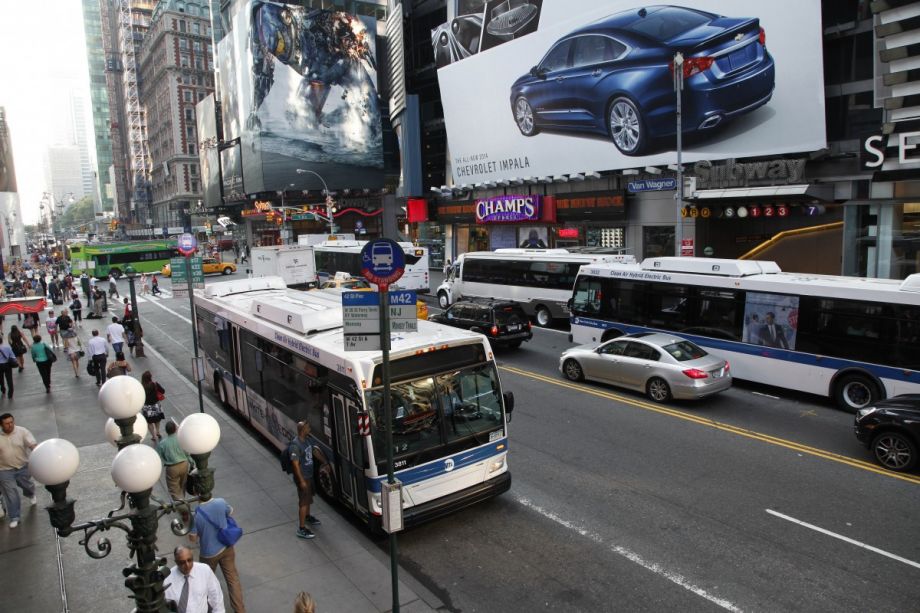So far, the mayors of 247 U.S. cities have committed to the Paris Climate Accord, despite President Donald Trump’s June announcement that he would withdraw. Now, Mayor Bill de Blasio has released a comprehensive plan outlining how New York City will attempt to comply with the goal of curbing global temperature rise to 1.5 degrees Celsius.
“In New York City, we have known for some time that we have to address the existential crisis of climate change,” Mayor de Blasio writes in the plan’s introduction. “Superstorm Sandy showed us the terrible cost of our warming planet. We had hoped we could depend on the federal government for leadership. Now we know we cannot. President Trump’s decision to pull the United States out of the Paris Climate Agreement has set us on a dangerous path of denial.”
The plan focuses on two deadlines: 2020 and 2050. City leaders had already committed to reducing greenhouse gas (GHG) emissions 80 percent below 2005 levels by 2050. To keep to the 1.5 degrees target, New York has to reach carbon neutrality, or zero net emissions. And timing matters. To comply with the Paris Agreement, cities need to actually “frontload” emissions reductions, meaning doing more, sooner — in New York City’s case, by 2020.
Actions are broken down into three categories: building and electrical grids, transportation and waste.

(Credit: City of New York)
Building and electrical grids: Fossil fuels burned for heat and hot water in buildings are the city’s largest source of GHG emissions, accounting for about 39 percent of the city’s total. Going forward, leaders plan to pursue legislation requiring that all large buildings limit those emissions by 2030 and 2035, respectively. From the plan:
This is the single largest action the city will implement to reduce GHG emissions and will affect over half the built floor area in NYC. This action will also require setting energy intensity requirements that take into consideration impacts on utilities, specifically tenant uses and economic activity.
The city also plans to retrofit city-owned buildings, adopt new building codes that require much lower energy design targets and implement a financing mechanism that treats clean energy and efficiency upgrades as a public benefit, thus allowing them to be funded through property bills with no money down. Officials will also work on a 100 percent renewable grid for city operations.
Transportation: The city plans to go primarily after private vehicles, and for good reason. Roughly 90 percent of the city’s transportation greenhouse gas emissions come from private car travel. In response, the city has committed that by 2050, four out of every five trips a New Yorker takes — or 80 percent — will be by foot, bike or on public transit.
The city will support that goal through subway and bus system improvements (which are sorely needed), new miles of protected bike lanes and an expanded bike-share with the aim of doubling the number of active cyclists by 2020. It also lists some sticks along with the carrots, like expanding “smart parking policy that prioritizes access to curb space, and exploring options for low emission zones that limit access in the city for the worst polluting vehicles.” As Curbed points out, it doesn’t mention congestion pricing, which, according to the news source “transit advocates believe [is] an obvious way to get people to drive less and opt for public transportation more often, leading to lower carbon emissions.” Mayor de Blasio, however, is reportedly not a fan of the tactic.
For those who are still set on driving, the city will also roll out better electric vehicle charging infrastructure.
Waste: New Yorkers will soon no longer have to sort their recyclables, which the city hopes will dramatically increase the cities recycling rate. They’ll also be able to drop off organic waste.
With 246 other cities committed to the Paris Accord stateside, New York’s document is no doubt the first of many. As Next City has repeatedly highlighted, cities, buses and density and can do a tremendous amount toward lowering the country’s total GHG output, and, increasingly, mayors see the task as their defining challenge.
“Estimates have shown [that] impacts from climate change could cost the American economy $500 billion annually by 2050, and that figure will only rise unless we work together to stem, and ultimately reverse, the amount of greenhouse gases entering our atmosphere,” a group of mayors wrote to the then President-elect last year.

Rachel Dovey is an award-winning freelance writer and former USC Annenberg fellow living at the northern tip of California’s Bay Area. She writes about infrastructure, water and climate change and has been published by Bust, Wired, Paste, SF Weekly, the East Bay Express and the North Bay Bohemian
Follow Rachel .(JavaScript must be enabled to view this email address)
















